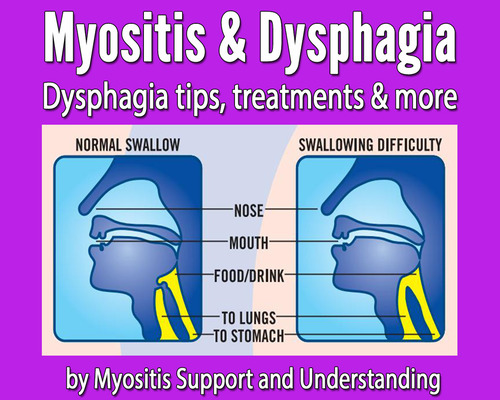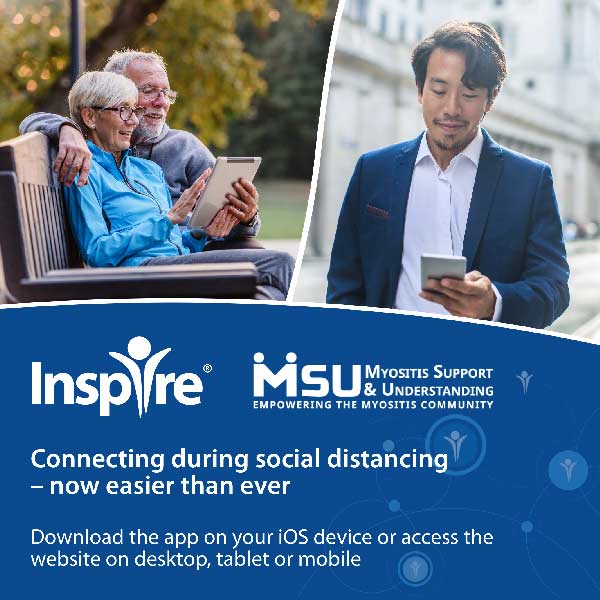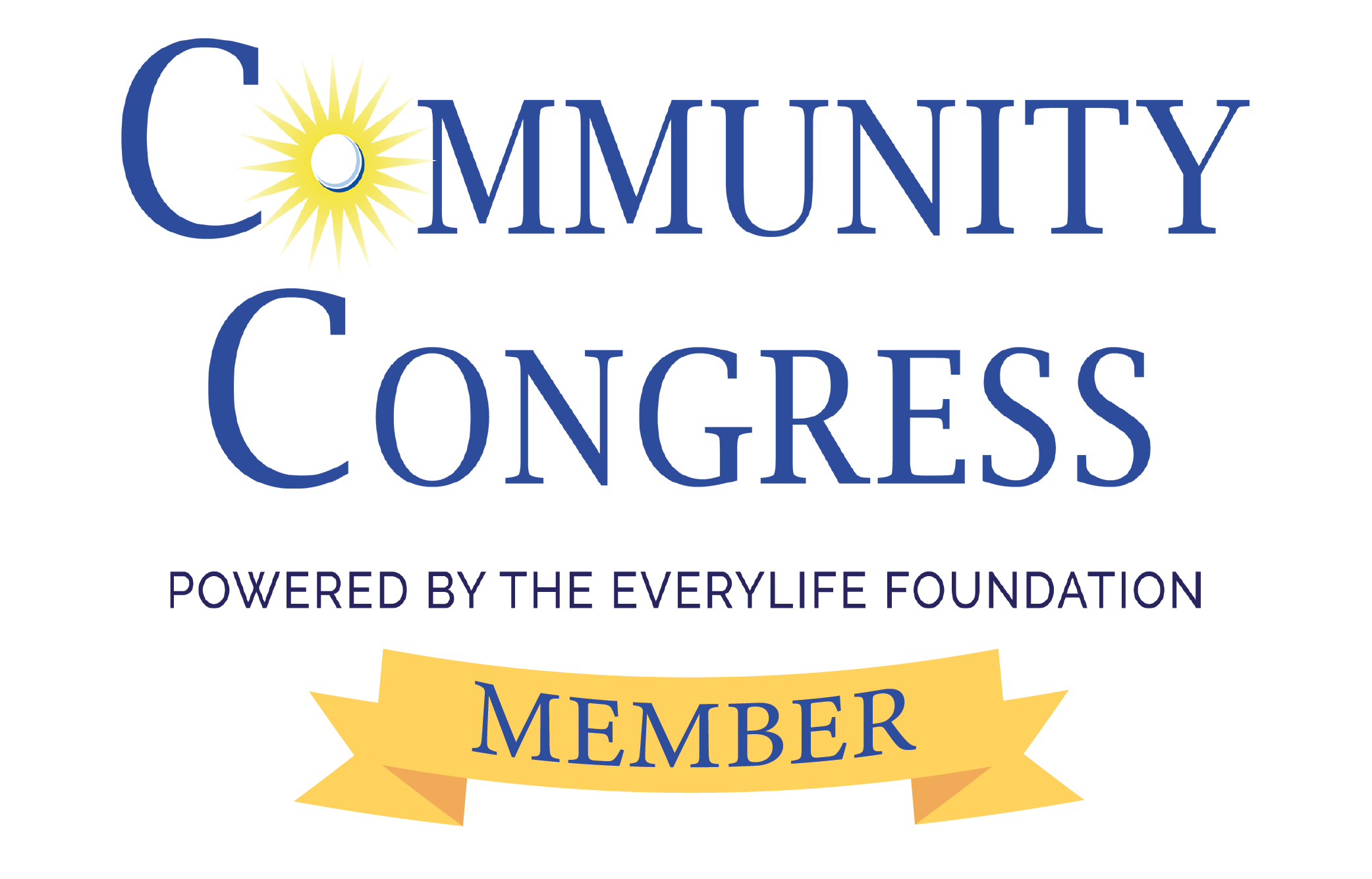One of many potential complications of Myositis, including those with dermatomyositis, polymyositis and inclusion body myositis, is dysphagia, or trouble swallowing. Myositis can cause the throat muscles to weaken thus making meal times difficult and sometimes dangerous.
As caregivers, we should be aware of what dysphagia is, learn about available treatments and procedures, as well as learn some tips that may provide help with swallowing food and liquids.
Swallowing disorders, such as dysphagia, can occur at any of the three stages in the swallowing process.
- Oral phase: Sucking, chewing and moving food/liquid into the throat
- Pharyngeal phase: Starting the swallowing reflex, squeezing food down the throat, and closing off the airway to prevent food or liquid from entering the airway (aspiration) or to prevent choking
- Esophageal phase: Relaxing and tightening of the openings at the top and bottom of the esophagus and squeezing food through the esophagus into the stomach
Symptoms of dysphagia can include inability to start the swallowing process, pain, an excessive amount of saliva, persistent coughing or choking while swallowing, frequent heartburn, overnight coughing, feeling like something is stuck in the throat or chest, weight loss and dehydration due to lack of eating and drinking and taking much longer than normal to finish a meal. These symptoms can cause poor nutrition, risk of aspiration pneumonia, less enjoyment of mealtimes and even embarrassment in social situations, which could lead to isolation and depression.
Some general tips to help your loved one can include:
- Take small bites and small sips.
- Concentrate during meal times and while eating; try to avoid talking.
- Learn the consistency of foods that can be easily swallowed and avoid those that cause coughing and choking.
- Ice down the throat with a bag of frozen vegetables or ice pack prior to eating.
- Lean the head forward when swallowing. Avoid tilting the head back, as this will cause more complications while trying to swallow.
While the tips above may help, there is no better alternative than seeing a speech pathologist.
Speech pathologists are trained in swallowing disorders and are able to diagnose dysphagia using a few methods. First, they observe the patient to check for correct posture and oral movements during eating and drinking while also looking at the strength of the muscles involved in swallowing.
Speech pathologists may also order testing such as a modified barium swallow where the patient will eat or drink food that contains barium and then the swallowing process is viewed on X-ray. An endoscopic assessment, a lighted scope is inserted into the nose and then the swallow can be viewed on a screen, may also be ordered to help make a diagnosis and prescribe treatment.
Once diagnosed with dysphagia, a speech pathologist will create a treatment plan that will include helpful information such as exercises to help improve muscle movement, positions and strategies to help make swallowing more effective and safe, and teach about specific food and liquid textures and consistencies to provide the patient with a diet that is easier to swallow.
There are treatments available to help those with dysphagia.
- Exercises that will help strengthen the throat muscles
- Medications to help alleviate symptoms (in some cases)
- Botox treatments
- Throat stretching through use of endoscopy or surgery
- Surgical cutting of certain muscles to allow for better swallowing
- Deep pharyngeal neurological stimulation is an intense stimulation program of the oral-pharyngeal muscles. DPNS stimulates the cranial nerves by directly touching specific areas within the mouth and throat. This causes the pharyngeal and lingual muscles to contract. Over time, this strengthens the patient’s gag reflex and helps to improve long-term swallowing ability.
- Thermal gustatory stimulation is a procedure performed by pressing a cold metal object against the back of the throat to elicit a swallow response. Improvements in swallowing ability are generally temporary.
- Some patients may require a feeding tube which is placed directly into the stomach, therefore bypassing the mouth and swallowing process altogether.
While these tips, exercises and treatments may be helpful, it is also a good idea to learn the Heimlich maneuver. There is a brief video that shows you the basics of the Heimlich as well as very basic CPR. This video is available on our website at www.UnderstandingMyositis.org. Please note that taking classes is a better option.
If you are not able to be home during mealtimes, some tips to make you feel comfortable could include:
- Signing up for a lifeline-type system that can automatically summon EMT’s in the event of an emergency.
- Leaving the front door unlocked if you are not going to be with your loved one during mealtimes or have a lock box installed and coordinate with your local EMT’s and Fire Company so they have a way to get in.
While dysphagia can be a serious complication of Myositis, there are many ways to help avoid choking and even strengthen the muscles involved in swallowing. Seeing a speech pathologist is the best, first step!
(Many of the tips were provided by real-life caregivers of IBM patients at the 2014 Annual Patient Conference by The Myositis Association during the Caregiver’s session. You can watch the Caregiver’s session on our website at www.UnderstandingMyositis.org)
Always remember to check with your doctor or healthcare team prior to making any changes in your treatment. This article is for informational purposes only and should not be mistaken for medical advice.
Tags: caregivers dysphagia









